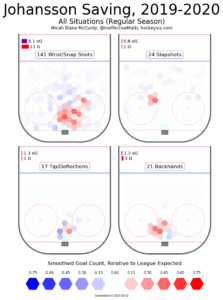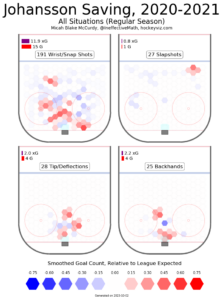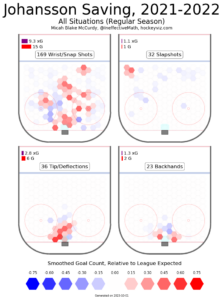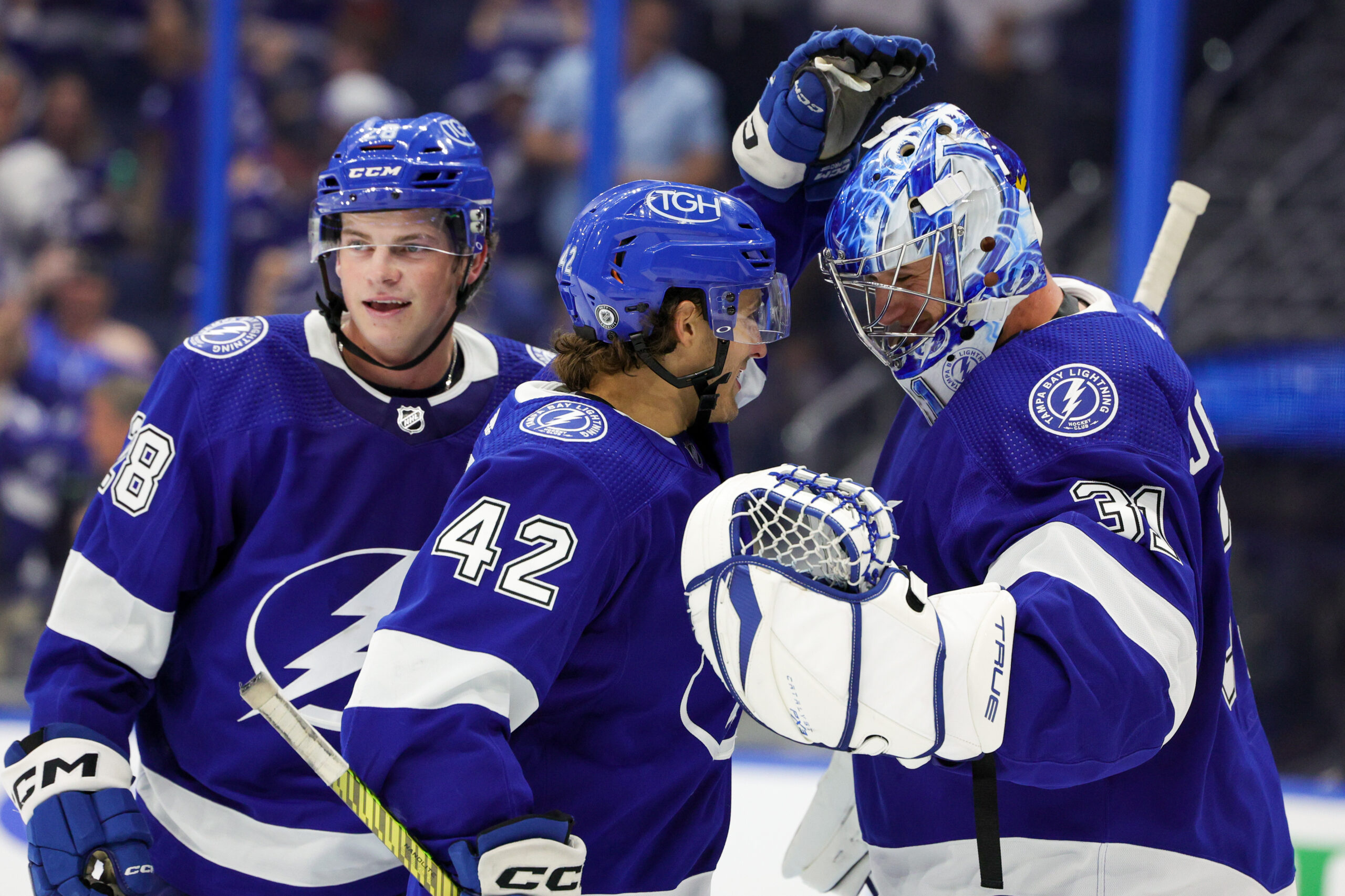The Tampa Bay Lightning were hit with really, really unfortunate news recently. Their two-time Stanley Cup-winning starting goaltender, Andrei Vasilevskiy, is going to miss a chunk of the season. As of now, the tentative starter appears to be Jonas Johansson. He has been deemed by many the “worst goalie [insert said person’s name] has ever seen play in an NHL game.” So, if he truly is the replacement plan for the starting job, what can he bring?
Jonas Johansson Deep Dive: Can He Be Serviceable Until Vasilevskiy Returns?
If you were to go on Twitter (Or X) right now, and search “Jonas Johansson worst” you will come across MANY tweets. From Scott Wheeler: “Jonas Johansson is maybe the worst goalie I’ve ever watched play in an NHL game. Probably *the* player in the league whose continued opportunities (now a fourth NHL club) confounds me the most.” Then, the famous John Vogl tweets: “I can say without hesitation that the Avs are getting the worst goalie I’ve ever seen during my 19 seasons covering the Sabres.” Oh, it keeps going.
It’s understandable, unfortunately, based on what he has shown early in his career. In 2019-20, amongst goalies with at least five starts, he was 11th worst in Goals Saved Above Expected Per 60 Minutes (GSAx/60). Then, in 2020-21, he ranked 12th worst in that same metric, within those same parameters. But it got worse, as in 2021-22, he actually ranked second-worst. Yet, last season was different.
With the Avalanche, the 28-year-old Swede played three games. Despite the insignificant sample size, for the first time, he held a GSAx that was positive. But there was something that was significant. He performed remarkably well in the AHL, with a save percentage of .920 and a goals against average of 2.33, en route to a 19-9-2 record.
Jonas Johansson Is A “Calculated Risk”
Three days ago, the Tampa Bay Times spoke with the Lightning goalie coach, Frantz Jean, about the Jonas Johansson signing. Frantz said that Johansson is a “calculated risk” as they decided to go with a younger backup than what they usually have. “The last probably three backups, we went with older guys. There was a reason for it… Vasy is much older and didn’t need to have a veteran guy and that veteran voice… Jonas Johansson comes in and brings a different energy.” Frantz mentions the fact that, unlike previous back-ups, Johansson is determined to establish himself as a starting-calibre goalie. Well, now is as good a chance as any to truly prove he can.
It also helps that Johansson himself is feeling confident, as he mentioned how much he enjoyed last season. Plus, as Frantz mentioned later on in the article, Johansson has a 6’5” frame, which isn’t easy to come by. “There’s not that many 6-5 guys around playing in the minors… For us, I mean, we’ve got to take some… risks, and bringing in an unproven young goaltender is one.”
Deeper Dive Into Johansson’s Rocky Start To His Career
Jonas Johansson has notably struggled, and Vogl has made it very clear just how poor it was. But let’s break it down further. Using MoneyPuck’s goalie stats, they break down shots coming from high-danger, medium-danger, and low-danger areas.
Over the last four seasons that Johansson has played, he has ranked 11th worst, 20th worst, eighth worst, and, last season, eighth best in low-danger save percentage (LDSV%). Meanwhile, he ranked 12th best, 43rd best, 16th worst, and then 23rd best in medium-danger save percentage (MDSV%). Finally, he ranked 22nd worst, 24th worst, 28th worst, and 10th best in high-danger save percentage (HDSV%).
Once again, last season he looked his best despite the minuscule amount of game time. But perhaps the biggest takeaway is the fact he consistently improved over the years when facing high-danger shots. That, and his notable struggles facing low-danger shots. Meanwhile, he has always been pretty solid when facing shots from medium-danger. Why is this notable?
Tampa Bay’s Stats for Shots Against
The reason those high, medium, and low-danger shots are important to note is that we can look at trends from the Lightning to see if Johansson’s strengths will be played to, to a degree. For example, if the Lightning defenders allow a high volume of low-danger shots compared to the rest of the league, then Johansson will need to be better in those areas. But if they don’t, maybe that will mask some weaknesses.
The Lightning, over those same four years, allowed the eighth least, second most, fifth most, and eighth most low-danger shots against. They also allowed the 12th most, fifth least, 13th least, and 12th least medium-danger shots against. Finally, they allowed the seventh least, fifth least, 14th most, and 12th most high-danger shots against. Looking at the Lightning defensive stats, they’ve seemingly improved over the last three seasons by allowing a high volume of low-danger shots, while getting worse when it comes to limiting shots from high-danger.
The Numbers and Their Meaning to Jonas Johansson
Essentially, looking at those numbers suggest that Johansson will have his work cut out for him. His struggles facing low-danger shots has been apparent, and a massive reason for concern. At the same time, the continuous rise of high-danger shots allowed is a reason to be concerned regardless of who is in net for Tampa Bay. With the defensive core seeing a lot of change, losing Ryan McDonagh especially, means new players must step up. The decline of Victor Hedman, though he remains their best defender, also adds to the worry.
However, Nicklaus Perbix is coming into this season with last year’s experience. He will look to take a big step forward after a largely successful rookie campaign. Then, there’s Erik Cernak, who is trying to establish himself as a McDonagh-type of defender, who is looking to prove he’s worth the contract he was given. Lastly, Mikhail Sergachev is looking to improve in his own end after a big year, where he started taking over the offensive workload that Hedman carried for so many years. Can they rally around to make Johansson’s job a little easier?
An Even Deeper Dive
Using HockeyViz, advanced tracking stats from Micah Black McCurdy (paid subscription required for most stats), we can break-down Jonas Johansson’s game even further. Not only that, but we can also see the Lightning’s defensive zone stats at a deeper level. To avoid having a blended milkshake, consisting of numbers and jumbled words describing said numbers, let’s pick out the patterns and display the visuals.




As shown above, Jonas Johansson has faced 2.63 tipped shots per game and allowed 14 goals to 7.9 expected goals. Now, that’s over the course of his career, which is not a lot. Based on that, that’s 0.4 tipped goals allowed per game versus 0.23 expected per game.
The reason it’s broken down into per game stats is to make a projection of sorts. Vasilevskiy has faced, over the last four seasons, 3.52 tipped shots per game, with an expected goal per game total of 0.29. Using these numbers, one can determine Johansson’s tipped goals allowed per shot faced (0.152) and the expected goals per tipped shot allowed against Vasilevskiy (0.082). Let’s say Johansson starts 15 games in Vasilevskiy’s absence. Using the 3.52 shots per game mark from Vasilevskiy, that’s 53 tipped shots allowed, and a projection of roughly eight goals allowed, on 4.35 expected goals. Doesn’t exactly spell confidence.
What The Lightning Must Do With Jonas Johansson in Net
Johansson is not good when he is getting screened. That’s why he gives up low-danger shots. That’s why he is projected, with the above stats, to struggle against tips and deflections. In order to maximize the impact that Jonas Johansson can have in a positive way, it starts in front of him. Directly. Meaning net-front battles. If the Lightning defenders can use their size and strength, which is so evident on paper, to clear out that traffic, it’ll go a long way.
Additionally, they had one of their worst seasons in recent memory when it comes to giving up tipped shots. They allowed 248 tipped shots against Vasilevskiy last season, compared to 207, 114, and 195 in the three seasons before. That must change. It’s easy to say, but if they can truly step up and do the little things in front of Johansson correctly and efficiently, there’s reason to believe he can be a serviceable goalie. Not to mention, if he can be closer to the version we saw last season, then he could maybe be even better than simply “serviceable”. But a lot needs to be done, and done right, with a little bit of luck sprinkled in.
Main photo: Nathan Ray Seebeck-USA TODAY Sports






